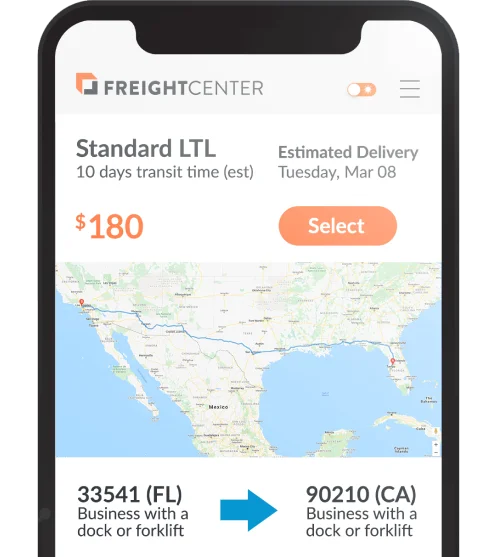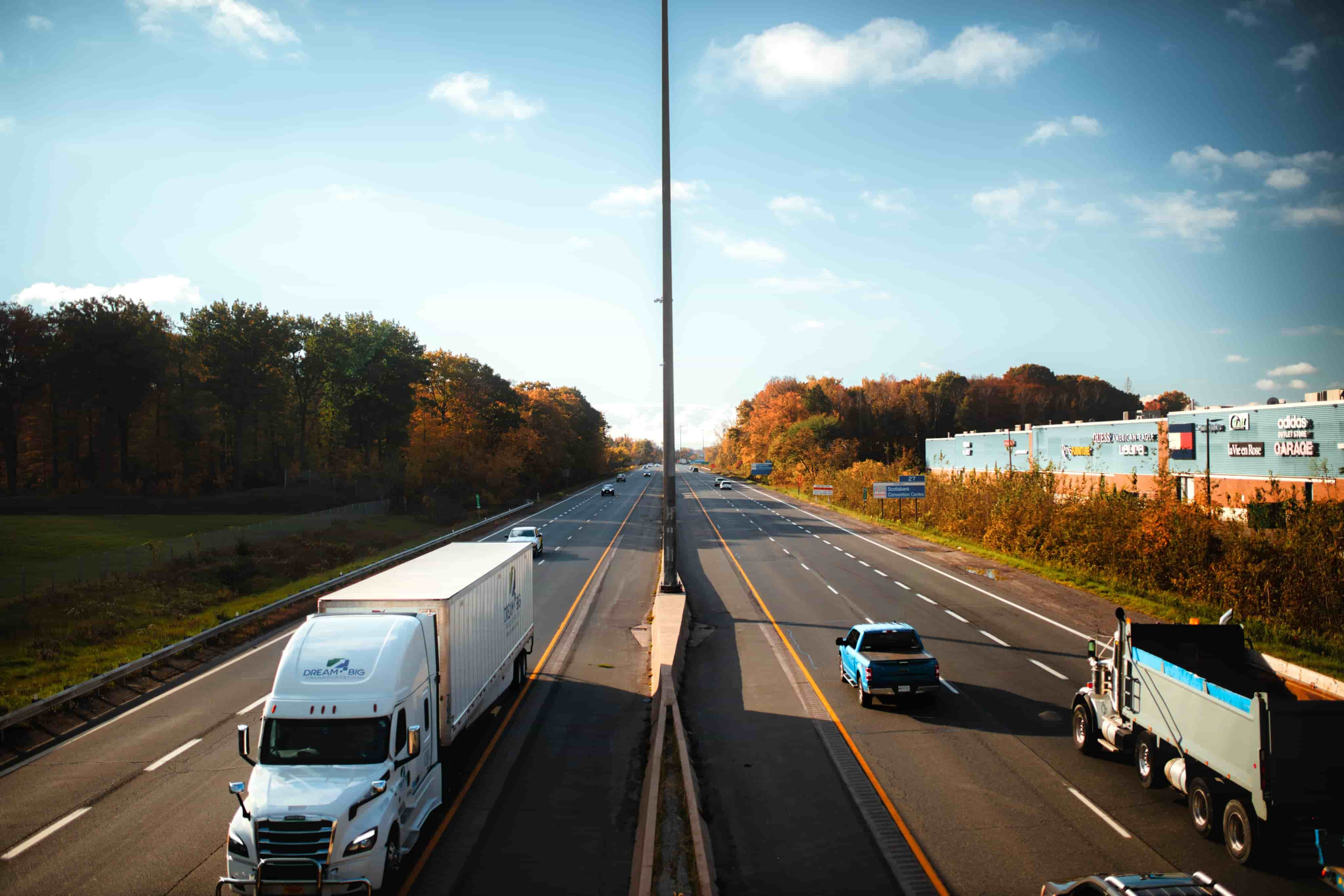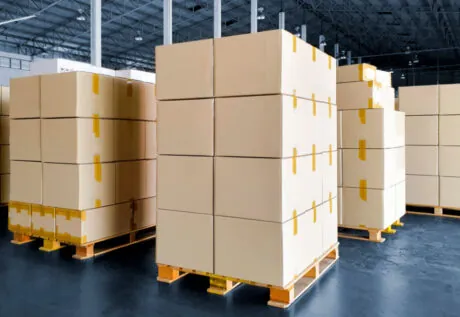
Partial Truckload
Discover the efficiency of Partial Truckload shipping! Ideal for medium-sized shipments, save on costs and improve logistics without needing a full truck. Get faster, flexible shipping solutions tailored to your needs!
Why Choose FreightCenter For Your Partial Truckloads?
- Compare rates from 50+ carriers
- Instant rates anytime
- Shipping solutions to anywhere in the US & Canada
- Unbeatable discounts on your PTL, LTL, FTL, rail, air, and more
- Automated tracking, paperwork & invoices
- Manage all freight quotes & shipments in one place
- 30+ years of transportation experience working for you!
Experienced PTL Shipping
Our experienced staff will manage all the variables needed to ensure a smooth shipping and safe arrival of your less-than-truckload cargo, including coordinating pickup and delivery, customs management, and permits. Planning is the key to successful cargo transport. We have earned a reputation for meeting and exceeding our customers’ expectations. 800.716.7608
We provide competitive freight shipping prices and an all-inclusive, easy-to-use shipping experience for our customers. Exceeding our customers’ expectations results in thousands of satisfied customer reviews and repeat business. We believe in the power of our customer relationships. Check out FreightCenter reviews from real customers, and learn what they have to say about their freight shipping experience!
- 2021, 2017 & 2016 Food Logistics’ Top Green Providers
- 2021 & 2018 Supply & Demand Chain Executives’ Pros to Know: Matthew Brosious
- 2020 & 2019 Top Food Logistics’ 3PL & Cold Storage Provider Award
- 2020 & 2019 Business Observer’s Top 500 Companies on the Gulf Coast
- 2020 & 2017 SmartWay® Transport Partner
- 2020 & 2017 Food Logistics’ Champions: Rock Stars of the Supply Chain
- 2020 Best of Palm Harbor Awards for Local Businesses
- 2017 Green Supply Chain Award from Supply & Demand Chain Executive
- 2017 Tampa Bay Business Journal Heroes at Work
- 2016, 2015, & 2012 Food Logistics Top 100 Software and Technology Providers
- 2013 Tampa Bay Business 100 by Tampa Bay Business Journal
- 2013 Top 100 Great Supply Chain Partners by SupplyChainBrain
- 2012 TIA Samaritan Award Honorable Mention
- 2013, 2011, & 2010 Diversity Business Top Businesses

What Our Customers Say about our PTL Service
Shippers choose our Partial Truckload (PTL) service for several key reasons. One primary reason is cost savings. PTL allows shippers to share truck space with others, meaning they only pay for the portion of the truck they use. This is particularly beneficial for those who don’t have enough goods to fill an entire truck. By splitting the cost with other shippers, they can save money while ensuring their products are delivered efficiently.
Another reason shippers prefer our PTL service is flexibility. PTL is perfect for shipments that are too large for less-than-truckload (LTL) but not large enough to require an entire truck. This middle ground offers shippers more options when planning their logistics. They can schedule shipments based on their specific needs without worrying about filling a whole truck or dealing with the complexities of LTL shipping. This flexibility helps shippers manage their inventory and meet customer demands more effectively.
Lastly, shippers use our PTL service because of the reliability and care we provide. Our PTL service ensures that goods are correctly handled and delivered on time. Shippers appreciate knowing their products are in good hands and will arrive at their destination without damage or delay. Our commitment to providing high-quality service and maintaining strong communication throughout the shipping process gives shippers peace of mind, making our PTL service a trusted choice for their transportation needs.
FreightCenter offers reliable, on-time, cost-effective partial truckload shipping services. Shipping partial load volumes can be expensive if you pay for a full container or trailer to ship your smaller freight. FreightCenter’s logistics services coordinate LTL freight scheduling to combine shipments from different companies to create a full truckload, lowering shipping costs for all companies utilizing the LTL service.
As an experienced shipping broker, we have a broad network of carriers that provides us with flexibility and the resources to coordinate shipments throughout North America so that we can arrange shipment to your destination, saving you freight costs and allowing you greater visibility of your transportation spend. Our network of over 11,000 carriers can provide access to the type of LTL trucking setup you need to transport your freight, including vans, flatbeds, step decks, and double drops. The carriers in our network are qualified professionals and maintain the highest DOT safety ratings, substantial liability and cargo insurance, industry certifications, and international documentation.
What Is A Partial Load?
A partial truckload, also known as PTL shipping, refers to a shipment that doesn’t require the entire capacity of a truck trailer. It is a cost-effective and flexible transportation solution that allows multiple smaller shipments from different shippers to be combined and transported. In contrast to full truckload (FTL) shipping, where the entire truck is dedicated to a single shipment, partial loads optimize trailer space and resources by consolidating multiple shipments.
The concept of a partial load arises from not all shipments requiring a full truck’s space. Many businesses have smaller quantities of goods or parcels that need to be transported, making it inefficient and costly to book an entire truck. Partial loads solve this problem by providing a shared transportation option that allows shippers to split the cost of the truck and utilize only the space they need.
Regarding partial load shipping, the critical advantage lies in its cost-saving potential. By sharing trailer space with other shippers, each party pays only for the space their shipment occupies, effectively reducing transportation expenses. This cost efficiency makes partial loads attractive to small and medium-sized businesses with lower shipping volumes or irregular shipment sizes.
Another benefit of partial load shipping is the flexibility it offers. Unlike FTL shipping, which requires precise coordination and timing to fill an entire truck, partial loads can accommodate shipments of varying sizes and be scheduled more flexibly. This flexibility allows shippers to optimize their logistics processes, as they can ship smaller quantities whenever needed without waiting for a full truckload.
In addition to cost savings and flexibility, partial load shipping offers improved transit times and reduced risk of damage. Since partial loads involve multiple shipments in a single truck, there is minimal handling and fewer chances for cargo to be damaged or lost in transit. This is especially advantageous for delicate or fragile goods requiring extra transportation care.
To facilitate the efficient handling and transportation of partial loads, specialized carriers and logistics providers play a vital role. These companies have expertise in consolidating and managing multiple shipments, optimizing routes, and coordinating delivery schedules. They have extensive networks and resources to handle partial load shipments efficiently, minimizing transit times and ensuring timely delivery.
In conclusion, a partial load is a shipment that doesn’t require the full capacity of a truck trailer, allowing multiple smaller shipments to be combined and transported together. It offers cost savings, flexibility, improved transit times, and reduced risk of damage. Businesses can efficiently transport smaller goods and optimize their supply chain operations by leveraging carriers’ and logistics providers’ shared resources and expertise. Whether you have small or irregular shipments, partial load shipping provides a practical and economical solution for your transportation needs
PTL vs. LTL Transit Times
Partial truckload shipments generally have reduced shipping times compared to less-than-truckload (LTL) shipments due to several key factors:
Direct Routing:
PTL shipments typically follow more direct routing from the origin to the destination. Unlike LTL shipments that often make multiple stops at various terminals and cross-docking facilities, PTL shipments involve fewer intermediate transfers. This means fewer delays are caused by additional handling, sorting, and rerouting processes. The streamlined routing of PTL shipments allows faster transit times and more efficient delivery.
Limited Handling and Transfers:
PTL shipments undergo less handling and fewer transfers compared to LTL shipments. With LTL, freight from different shippers is consolidated and deconsolidated at various terminals along the route. Each transfer introduces potential delays, as shipments must be sorted and organized before loading onto the appropriate truck. In contrast, PTL shipments are typically loaded directly onto the truck at the origin and delivered directly to the destination, minimizing the number of stops and handling processes. This reduction in handling and transfers leads to faster shipping times for shipments.
Expedited Service and Priority Treatment:
Carriers specializing in PTL services often provide expedited service and prioritize shipments due to their larger volumes or more actual freight. Carriers understand that Partial load shipments require dedicated truck space and allocate resources accordingly to ensure efficient transport. This priority treatment means shipments are given higher handling, loading, and transportation precedence. Carriers strive to meet the specified delivery timeframes for shipments, resulting in reduced shipping times compared to LTL shipments.
Optimized Trailer Utilization:
PTL shipments allow for optimized trailer utilization compared to LTL shipments. In LTL shipping, trucks are filled with smaller shipments from different shippers, resulting in less efficient use of trailer space. This can lead to longer transit times as the truck makes multiple stops for loading and unloading. With PTL shipments, however, the trailer is typically filled with fewer, larger shipments or consolidated loads from a limited number of shippers. This optimized trailer utilization allows for faster transportation, as fewer stops are required for loading and unloading along the route.
Efficient Carrier Networks and Resources:
Carriers specializing in PTL services often have well-established networks and resources, contributing to reduced shipping times. These carriers have developed efficient routes, strong partnerships with reliable terminals, and a fleet of trucks dedicated to shipments. Their expertise and network enable them to plan and execute shipments more effectively, minimizing delays and ensuring timely delivery. Additionally, carriers may leverage technology and real-time tracking systems to closely monitor shipments and proactively address any potential issues impacting shipping times.
While PTL shipments generally offer reduced shipping times compared to LTL, it’s essential to consider that actual transit times can vary depending on factors such as the distance between the origin and destination, traffic conditions, weather events, and any specific shipping requirements. Working with a reputable carrier and providing accurate and detailed shipment information can help optimize shipping times and ensure smooth transportation.
When it comes to pricing for partial truckload (PTL) shipments, several factors come into play. These factors can influence the overall cost of the shipment and help determine the pricing structure. Here are four key factors that impact PTL pricing:
Does your load weigh 5,000 to 25,000 pounds? What is the number of pallets you are going to be shipping?
Is your shipment Fragile or Durable? Is it consolidated into one multi-pallet unit or multiple pallets?
Does it need to be expedited? Do you need your shipment to show up in a specific timeframe? Shippers that want to use PTL have to be flexible. There isn't always a trailer that has enough space for your shipment.
Do you have specific loading or unloading requirements? Do you need any special equipment to load or unload your shipment?


Compare Partial Truckload Prices Instantly
Trust the experts at FreightCenter to give you the best prices and shipping options. The cheapest shipping cost from all the top carriers is just a few steps away. Fill in brief details about your shipment and receive instant Specialized Freight Services from leading freight carriers in one easy place. Businesses that ship products quickly become aware of the many options available.
You often have items you must send but can only fill part of the truck. PTL and LTL services give shippers the option of sending items to a location on an ongoing basis, whether shipping a few pallets or a complete load. Third-party logistics providers specialize in pairing shippers with the transportation services they need. Logistics experts know how to find the right truck to fulfill the shippers’ needs.
If the shipper only needs 20 feet of space in a truck. In that case, logistics professionals have the knowledge and resources to match that carrier needing a 20-foot load with the shipper that requires 20 feet of truck space. But PTL and LTL can be confusing since they seem, on the surface, to refer to the same thing. However, there are differences between the two.
With the many parts of the shipping industry, LTL and FTL are the most dominant types of shipping. One is aimed at established businesses with massive shipping budgets, while the other is at smaller-medium-sized businesses. The rarer PTL isn’t in the same running as LTL and FTL, but it can be a hidden gem for a company that can utilize it. If that’s you, contact a freighter or broker and see what PTL can do for you!
Partial Truckload FAQs
Q. What is partial truckload shipping?
Partial truckload shipping is a transportation method that combines multiple smaller shipments from different shippers into a single trailer. It falls between less-than-truckload (LTL) and full-truckload (FTL) shipping. With a partial truckload, you pay for the space and weight your shipment occupies within the trailer, allowing you to share the costs with other shippers and achieve cost savings.
Q. When should I choose partial truckload shipping?
Partial truckload shipping is a great option when your shipment is too large for LTL but doesn’t require an entire truck. It is suitable for loads that weigh between 5,000 and 20,000 pounds or occupy more than six pallets. If you have time-sensitive or fragile freight, partial truckload can also provide more control and reduced handling compared to LTL.
Q. How does partial truckload differ from LTL and full truckload?
Partial truckload differs from LTL because it involves sharing trailer space with other shippers, whereas LTL shipments are combined with multiple loads in a hub-and-spoke system. Partial truckload offers greater security and reduced handling compared to LTL. In contrast, a full truckload involves booking an entire truck for your shipment, providing maximum capacity and faster transit times but at a higher cost.
Q. What are the advantages of partial truckload shipping?
Partial truckload shipping offers several advantages, including cost savings, reduced handling, increased security, and faster transit times compared to LTL. It allows more flexibility and control over your shipment than a full truckload. Additionally, partial truckload is more environmentally friendly as it reduces empty miles and optimizes trailer utilization.
Q. How does FreightCenter handle partial truckload shipments?
FreightCenter specializes in providing efficient and cost-effective solutions for partial truckload shipments. We leverage our extensive network of carriers to find the most competitive rates and reliable transportation options for your specific needs. Our online platform lets you quickly obtain quotes, compare rates, book shipments, and track your cargo in real-time. Our dedicated customer support team can assist you throughout the shipping process, ensuring a smooth and hassle-free experience.
Q. Is partial truckload shipping suitable for all types of freight?
Partial truckload shipping suits many freight types, including palletized goods, large or bulky items, fragile goods, and time-sensitive shipments. However, certain restrictions or limitations may depend on the carrier and specific shipment requirements. It’s best to consult with our team at FreightCenter to determine if partial truckload is the right choice for your particular freight.
Q. How do I determine the cost of a partial truckload shipment?
The cost of a partial truckload shipment is calculated based on factors such as the weight, dimensions, distance, and specific requirements of your freight. FreightCenter’s advanced technology and expertise allow us to provide accurate and competitive pricing for your partial truckload shipments. We can generate customized quotes tailored to your needs by providing detailed information about your freight.
Q. How can I track my partial truckload shipment?
FreightCenter provides a user-friendly online platform that allows you to track your partial truckload shipment in real time. You will receive tracking information once your shipment is booked, including the carrier details and a tracking number. Simply enter the tracking number on our website to access up-to-date tracking information and monitor the progress of your shipment from pickup to delivery.
Q. Can I insure my partial truckload shipment?
Yes, you can ensure your partial truckload shipment for added protection. FreightCenter offers cargo insurance options to safeguard your freight against loss or damage during transit. It’s important to discuss your insurance needs with our team and understand your coverage options.
Q. How do I get started with partial truckload shipping through FreightCenter?
Getting started with partial truckload shipping through FreightCenter is easy. Contact our team by phone or through our website to discuss your shipment requirements. Our experienced logistics experts will guide you through the process, provide you with competitive rates, and assist you in booking your partial truckload shipment.
3 Advantages of Using FreightCenter for a Partial Truckload
3 Advantages of Using FreightCenter for a Partial Truckload
Cost Savings:
One of the major advantages of utilizing FreightCenter for partial truckload shipping is the cost savings it provides. With partial truckload shipping, you only pay for the space and weight your shipment occupies within the trailer rather than booking an entire truck. This cost-effective solution saves you on transportation expenses, especially when shipping smaller or less-than-truckload shipments. FreightCenter leverages its extensive network of carriers to find the most competitive rates for your partial truckload shipments, ensuring you get the best value for your money.
Increased Flexibility:
Partial truckload shipping offers greater flexibility than full truckload shipping. With FreightCenter, you can combine your shipment with other compatible loads to maximize trailer utilization. This flexibility allows for more efficient use of transportation resources, reduces wasted space, and minimizes empty miles. By leveraging our load consolidation and optimization expertise, we can help you find the most suitable partial truckload solution that meets your specific requirements while optimizing cost and efficiency.
Streamlined Logistics Management:
FreightCenter provides a comprehensive logistics management platform simplifies partial truckload shipping. Our user-friendly online portal allows you to obtain quotes, compare rates, book shipments, and track your cargo all in one place. Our advanced technology and automated systems enable real-time tracking and proactive communication, informing you of your shipment's status from pickup to delivery. Additionally, our dedicated customer support team is available to assist you throughout the process, offering guidance and resolving any queries or issues that may arise. With FreightCenter, you can enjoy streamlined logistics management, saving you time and effort.
